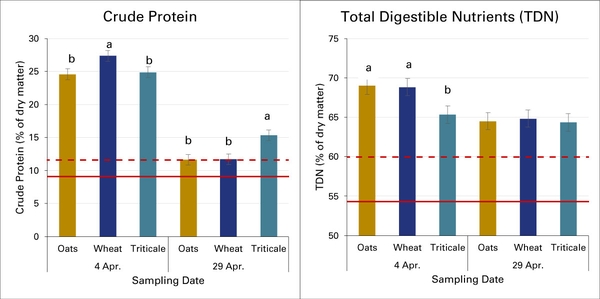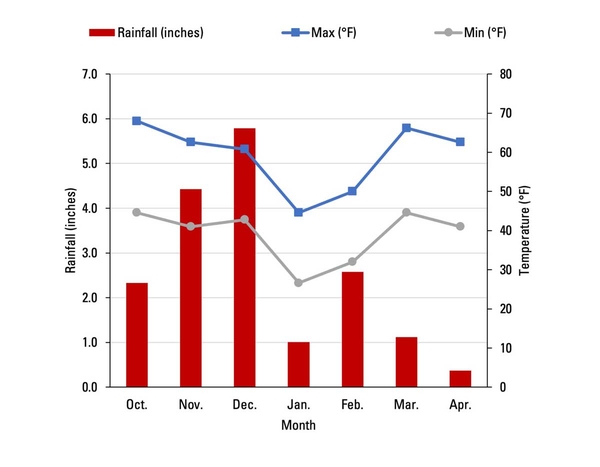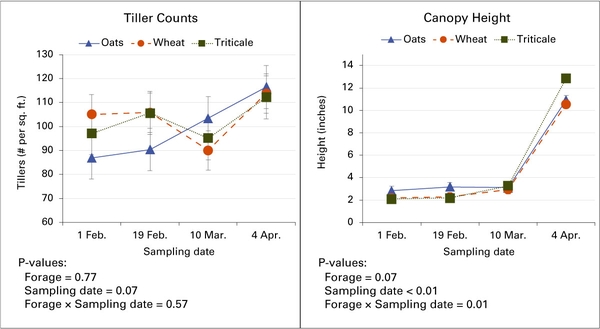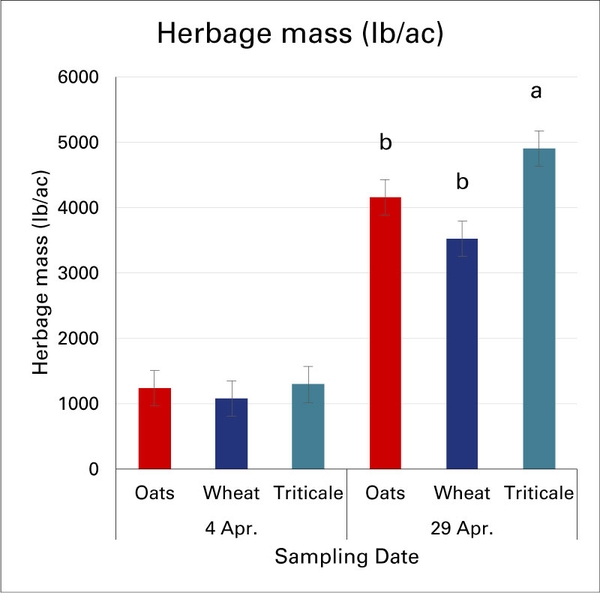Forages such as wheat, rye, oats, barley, triticale (collectively known as small grains), and ryegrass provide nutritious herbage for grazing livestock during late autumn and spring in North Carolina. These cool-season annual forages can also be conserved as hay or silage and be fed to livestock as supplements or in periods of forage shortage in the field.
This publication provides information on the utilization of cool-season annual forages in pasture-based livestock systems. We also report the findings from an on-farm demonstration trial that describes the establishment dynamics and performance of three cool-season annual forages in North Carolina.
Cool-Season Annual Forages in Pasture-Based Systems
Cool-season annual forages can complement and improve the quantity and the nutritive value of the forage offered in perennial-based systems, ultimately helping to improve livestock responses. These forages can also be part of a crop rotation with other warm-season annuals such as crabgrass, pearl millet, sudangrass, corn, or sorghum. In addition, cool-season annual forages can also be overseeded into existing perennial pastures, such us bermudagrass, as a strategy for extending the grazing season into the autumn and spring, especially in systems that rely on perennial warm-season grasses such as bermudagrass and switchgrass (Aiken 2014).
Animal performance in terms of gains in live weight and milk production is often greater during the cool-season compared to the warm-season. This can be attributed to the higher nutritive value (protein and energy) of the forage and reduced heat stress of the grazing cattle, which leads to greater forage intake (Dubeux et al. 2016). In addition, cool-season annual forages can be preserved as hay or silage, which allows for flexibility in management options for forage managers. A planting guide for North Carolina can be found in the Planting Guide for Forage Crops in North Carolina Extension publication AG-266.
Plot Establishment and Management
An on-farm demonstration trial was conducted in Roxboro, North Carolina from autumn 2015 to spring 2016. In preparation for the trial, the field was mowed for hay, which was mainly volunteer summer forage such as crabgrass, on October 13, 2015. The hay was baled and removed from the field. Glyphosate (1 qt/ac) was applied on October 16 and oats, wheat, and triticale were planted on October 23. A Great Plains no-till drill was used to plant oats (cv. Cosaqoe), wheat (cv. Malabar), and triticale (cv. Trical 815) at a rate of 100 lb/ac on a pure live seed basis. Planting depth was 1½ in. The plots were rain fed. On September 4, 2015, ammonium sulfate fertilizer (21-0-0) was applied at 200 lb per acre. On March 24, 2016, fertilizer was applied with 400 lb/acre of 26-0-26. Given the observed weed pressure, there was no need for any herbicide application. The weather during the experimental period is presented in Figure 1.
Evaluation: Establishment, Nutritive Value, and Productivity Estimates
Data on ground cover (amount of the ground covered by the green tissue of the desired species), canopy height, tiller counts, and light interception (amount of light intercepted by the canopy) were collected four times to characterize establishment and development of the planted forages. Measurements were taken every three weeks starting on February 1, 2016 (101 days after planting date) and ending on April 4, 2016. Dry matter yields were collected twice (on April 4 when forages were at flag leaf ligule visible and boot swollen, Feekes 9 to 10 or Zadoks 39 to 45, and April 29 at fully headed stage, Feekes 10.5 or Zadoks 58, (Weiz 2013) by clipping to 2 in. stubble height. Samples were analyzed in the laboratory for crude protein (CP) and total digestible nutrients (TDN) as estimates of nutritive value.
Crude protein was estimated by the concentration of total nitrogen in the tissue, while TDN represents an estimate of energy that is commonly used in North Carolina for balancing livestock rations (Poore 2024). For more information and interpretation of laboratory results and forage quality indices, see Extension publications AG-792, Forage Quality Concepts and Practices and AG-824, Forage Quality Indices to Select Hay.
Canopy Dynamics
Ground cover during the establishment phase was similar among forages (Figure 2). Across forages, ground cover was greater early (by February 1) and later (by April) in the season, with a slight decline in between, which was probably a function of the increased number of brown tissues caused by freeze damage, especially for oats. Ground cover and canopy light interception followed the same trend, as expected. Lower canopy resulted in lower canopy light interception values. By the last measurement taken on April 4, there was no difference among small grains for either ground coverage or light interception (Figure 2).
Tiller count dynamics were similar among the forages (Figure 3). The greater number of tillers was recorded at the last sampling date on April 4. Although there were no differences in tiller counts across sampling dates, there was a trend towards greater number of tillers at the last sampling date (by April 4) and there was a distinct and consistent pattern of increased tillering for oats, in contrast with both triticale and wheat which declined by mid-March (Figure 3). This response pattern can be explained, in part, because oats are not affected by hessian fly .
Canopy height remained below 4 in. until March 10 for all forages. By the last sampling date of April 4, the canopy height for triticale was close to 13 in., which was higher than oats and wheat, which were close to 10 in. (Figure 3). The rapid increase in canopy height coincides with the period of higher temperatures that ranged from 45◦ to 70°F from mid-March to early-April (See Figure 1).
Productivity (Herbage Mass)
Herbage mass was similar among forages when harvested on April 4 (about 2,000 lb/ac). (See Figure 4). The plant canopy was still primarily in the vegetative stage. An earlier grazing event would have been possible when the canopy was about 6 in. tall. A key point to remember is that stubble height after defoliation (clipping or grazing) should be between 3 to 4 in. tall to ensure adequate regrowth and persistence of the forages. Herbage mass measured on April 29 was greater for triticale and lower for, but not different between, wheat and oats (Figure 4). This clipping event is representative of a situation in which the goal is to produce silage by targeting the soft dough stage for clipping.
Nutritive Value
Longer growing intervals allow for greater herbage mass accumulation in small grains (Edmisten et al. 1998). Nevertheless, the more mature the forage, the lower the nutritive value. This was the case for both crude protein (CP) and total digestible nutrients (TDN). The average forage CP on April 4 was 25%, as compared to 13% on April 29. On April 4, the forage CP was greatest for wheat, followed by triticale and oats which were similar (Figure 5). In the April 29 sampling, the triticale CP concentration was greatest, while oats and wheat were similar. Oats and wheat had greater TDN compared to triticale on April 4, although on April 29, there was no difference among the three forages. The TDN value for triticale remained consistent (at about 65%) across the two harvest dates, while the TDN decreased from April 4 to April 29 for oats and wheat (Figure 5).

Figure 5. Crude protein (CP) and total digestible nutrients (TDN) values by date and forage type. Bars followed by different letters, within sampling date, are statistically different. Red horizontal lines indicate % CP and TDN requirements in the diet of a dry cow (solid line; CP = 8%, TDN = 54%) and lactating cow (dashed line; CP = 11%, TDN = 60%).
Match Between Forage Nutritive Value and Livestock Requirements
Let’s assume you are buying hay and you have two choices of forage to be purchased: forage from the April 4 cut or forage from the April 29 cut. Which of these options should you buy to feed to a lactating cow compared to a dry cow during a 90-day period? This question becomes far more important if you were considering buying hay for the entire winter.
To answer the previous question, you need to first understand the nutrient requirements of the type of livestock. Second, you will need to assess the nutritive value data and attempt to match the supply (from the forage) and the demand (by the animal) of energy, protein, and other mineral requirements. Economics play a big role in this decision. Biologically, preventing overfeeding or underfeeding is an important strategy to keep healthy, productive animals and for the efficient use of resources in the overall system.
The two red lines in Figure 5 indicate the % CP and TDN needed in the diets of a dry cow (about 1,200 lb, last 1/3 of pregnancy; solid line) and a milking cow (about 1,200 lb, first 90 days of lactation; dashed line). If forage was the only source of feed for livestock, both types of hay would provide adequate CP and TDN to meet the animal requirements for energy and protein.
Animal Responses under Grazing Conditions
Animal responses under grazing are the ultimate proof of forage quality. In North Florida, Dubeux et al. (2016) conducted an experiment to evaluate forage productivity (herbage mass, nutritive value) and animal responses (average daily gain and gain per acre) of steers that grazed three small grain-annual ryegrass mixtures. The mixtures were rye-ryegrass, oats-ryegrass, and triticale-ryegrass. The results showed similar animal responses, although the oat-ryegrass and triticale-ryegrass mixtures showed a more even distribution of forage throughout the growing season. The rye-ryegrass mixture offered earlier grazing in the growing season and was more consistent across years, which can be attributed to the greater drought tolerance of rye. The stocking rate varied among mixtures within sampling dates and years (ranging from 0.7 to 2 animal units (990 lb body weight) per acre, although the average season-long stocking rate from December to April was similar among mixtures and supported an average daily gain of 2 lb/head/day. In a different trial in Alabama, Mullenix et al. (2012) reported an animal average daily gain of 3 lb/head/day for oats-ryegrass, 2.4 lb/head/day for rye-ryegrass, and 2.7 lb/head/day for the oat-rye-ryegrass mixtures.
Take-Home Messages
- Cool-season annual forages such as small grains (oats, wheat, triticale, rye), planted alone or in mixtures with ryegrass, can provide high nutritive value forage for feeding grazing livestock.
- The nutritive value of the forage harvested in both sampling dates (stages) in this trial was more than sufficient (April 4 harvest) and sufficient (April 29 harvest) to meet the needs of both a dry cow and a lactating cow.
- Cool-season annual forages have a strategic role in extending the grazing season in North Carolina by complementing the forage provided by perennial forages.
References
Aiken, Glen E. 2014. “Cool-Season Annual Grasses Interseeded into a Bermudagrass with Improved Cold Tolerance for Grazing in the Upper South.” Forage and Grazinglands 12, no. 1: 1-6.
Chamblee, Douglas S. and J. Paul Mueller. 1999. Extending the Grazing Season: Growing Annual or Perennial Grasses or Legumes in Mixture with Hybrid Bermudagrass. NC State Extension Technical Bulletin 315. Raleigh, NC: NC State Extension.
Dubeux, José C. B., Nicolas DiLorenzo, Ann Blount, Cheryl Mackowiak, Erick R. S. Santos, Hiran M. S. Silva, Martin Ruiz-Moreno, and Tessa Schulmeister. 2016. “Animal Performance and Pasture Characteristics on Cool-Season Annual Grass Mixtures in North Florida.” Crop Science 56 , no. 5: 2841–52.
Edmisten, Keith L., James T. Green Jr, J. Paul Mueller, and Joe C. Burns. 1998. “Winter Annual Small Grain Forage Potential. I. Dry Matter Yield in Relation to Morphological Characteristics of Four Small Grain Species at Six Growth Stages.” Communications in Soil Science and Plant Analysis 29, no. 7-8: 867-879.
Gadberry, Shane. 2019. Beef Cattle Nutrition Series Part 4: Formulating Rations. FSA3080. Little Rock, AR: University of Arkansas – Division of Agriculture, Research & Extension.
Mullenix, M. Kim, Elias J. Bungenstab, John C. Lin, Brian E. Gamble, and Russell B. Muntifering. 2012. “Case Study: Productivity, Quality Characteristics, and Beef Cattle Performance from Cool-season Annual Forage Mixtures". The Professional Animal Scientist 28, no. 3: 379-386.
Poore, M. 2024. Interpreting forage analysis reports for beef cows. North Carolina Cooperative Extension.
Weiz, Randy. 2013. Small Grain Production Guide. AG-580. Raleigh, NC: NC State Extension.
Publication date: April 5, 2024
AG-962
N.C. Cooperative Extension prohibits discrimination and harassment regardless of age, color, disability, family and marital status, gender identity, national origin, political beliefs, race, religion, sex (including pregnancy), sexual orientation and veteran status.




